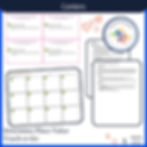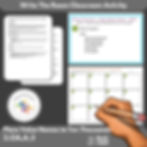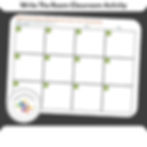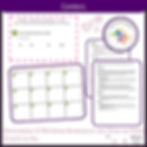Introduction to Executive Functioning and ADHD
Executive functioning is the set of skills we use to get things done, from planning and organizing to remembering details and managing our time and space effectively. For individuals with ADHD, both kids and adults, these tasks can be particularly tough. Their brains process information differently, making it hard to track tasks and follow through. ADHD isn't solely about difficulty focusing; it also encompasses struggles with organizing thoughts, planning ahead, and impulse control. When discussing executive functioning in the context of ADHD, we're shedding light on the challenges those with ADHD face in managing everyday tasks that might be easier for others. Understanding these struggles is crucial for recognizing the importance of specific goals and supports, such as those outlined in IEP (Individualized Education Program) plans, particularly in educational settings. Acknowledging these hurdles is a fundamental step towards fostering a supportive environment for both learning and personal development.
Key Takeaways
Executive functioning skills are essential for getting tasks done effectively.
Individuals with ADHD may struggle with tasks related to planning, organizing, and managing time and space.
Understanding the challenges of executive functioning in the context of ADHD is crucial for providing appropriate support.
IEP plans play a significant role in addressing the specific needs of individuals with ADHD in educational settings.

Understanding IEP Goals for Students with ADHD
IEP goals for students with ADHD focus on improving their executive functioning skills, crucial for academic success and daily life. Executive functioning involves planning, organizing, time management, and problem-solving abilities. These skills often pose challenges for kids with ADHD. By setting clear, measurable goals, an Individualized Education Plan (IEP) targets specific areas needing support. It's about finding strategies that work for the student, allowing them to thrive both in and out of the classroom. Goals might address improving concentration on tasks, managing schoolwork, participating in class, or handling emotional responses. It’s not just about academic grades but helping students with ADHD navigate their school day effectively, making learning a more accessible and enjoyable experience.
Goal 1: Enhancing Organizational Skills
Kids with ADHD often struggle to keep things in order. So, goal one is all about getting those organizational skills sharp. What does this look like? Think about breaking tasks down into manageable chunks and setting up a simple system for keeping track of homework and assignments. Use tools like planners or apps to set reminders for deadlines. It’s all about making a plan that’s easy to follow. This way, they can tackle one thing at a time without feeling overwhelmed. By practicing these steps, keeping organized becomes less of a chore and more of a habit.
SMART IEP Goal: By the end of the school year, Mia will demonstrate improved organizational skills by effectively breaking tasks down into manageable chunks, utilizing a system to track homework and assignments, and setting reminders for deadlines using planners or apps.
Scenario:Mia is a high school student who struggles with keeping track of her assignments and often forgets deadlines. By working on this SMART IEP goal, she will become more organized and better able to manage her workload. As a result, Mia will experience reduced stress levels, improved academic performance, and a sense of accomplishment.
Goal 2: Improving Time Management Abilities
Kids with ADHD often struggle to keep track of time. They can lose track of deadlines or underestimate how long tasks will take. The goal here is to get them better at managing their time. This means teaching them to use tools like planners or digital apps to make a schedule. We also encourage setting reminders for important tasks and breaking bigger tasks down into smaller, more manageable parts. This approach helps them not just see the big picture but also tackle each part step by step, making it less overwhelming. It's about practicing these skills until they become second nature. Remember, improving time management is a process, and it takes patience and consistency.
Smart IEP Goal: By the end of the semester, the student will independently create and follow a daily schedule using a planner or digital app, with reminders for important tasks, demonstrating improved time management skills in at least 80% of assignments.
Scenario: Amy, a high school student with ADHD, often struggles to keep track of assignments and manage her time effectively. By achieving this goal, Amy will be able to better prioritize her tasks and complete assignments on time, leading to improved academic performance and reduced stress levels.
Goal 3: Boosting Working Memory
Improving working memory is key for students with ADHD. Forget about fancy terms, let's keep it simple. Think of working memory as the mental sticky notes we use to hold onto info while we tackle tasks. For students with ADHD, it's like their sticky notes don't stick as well. The goal here is to make those notes stick better. First, practice makes perfect. Use memory games or apps designed to boost brain power. Second, break tasks into smaller steps. It's easier to remember a few steps at a time. And third, encourage note-taking. Writing things down can help transfer info from those slippery mental notes to something more solid. These strategies aren't just for school but for life. Making working memory stronger is all about giving students the tools to hold onto information longer, helping them tackle tasks more effectively.
Smart IEP Goals:
Scenario:Student: Alex
Goal: By the end of the semester, Alex will increase their working memory capacity by consistently improving their performance in memory games and exercises, as measured by frequency of successfully completed tasks.
Outcome: Alex's increased working memory capacity will allow them to retain and recall information more effectively, leading to better academic performance and reduced stress during exams.
Example Scenario:
Student: Emily
Goal: By the end of the school year, Emily will demonstrate improved organizational skills by effectively breaking down tasks into manageable steps with 80% accuracy across various subjects and assignments.
Outcome: Emily's enhanced organizational skills will enable her to prioritize tasks effectively, manage her time efficiently, and improve her overall academic performance across different subjects.
Goal 4: Increasing Attention to Detail
To get better at paying attention to detail, it's key to set specific goals. For a student with ADHD, this might mean taking steps to double-check their work for mistakes or making sure they understand instructions fully before starting a task. Here are simple strategies to help increase attention to detail: First, break tasks into smaller, manageable parts. This makes it easier to focus and not get overwhelmed. Second, use checklists. They're a great tool for making sure no step or detail is missed. Also, setting up a quiet, distraction-free workspace can really help to concentrate better. Lastly, practicing mindfulness or short meditation exercises can improve overall focus. By sticking to these strategies, attention to detail can become a stronger skill over time.
Smart IEP Goals:
By the end of the semester, the student will independently identify and correct at least 80% of errors in their assignments, as measured by teacher observation and feedback.
Within 2 months, the student will demonstrate improved understanding of instructions by summarizing them back to the teacher before beginning a task, with at least 90% accuracy, as recorded in progress notes.
Scenario:
By the end of the semester, David, a 10th-grade student who struggles with attention to detail, will independently identify and correct at least 80% of errors in his assignments, as measured by teacher observation and feedback.
Within 2 months, Marsha, a 7th-grade student with executive functioning challenges, will demonstrate improved understanding of instructions by summarizing them back to the teacher before beginning a task, with at least 90% accuracy, as recorded in progress notes.
Goal 5: Developing Problem-Solving Strategies
ADHD can make solving problems tough. Kids with ADHD often act on impulse, missing the step where they think things through. Goal 5 aims to build a toolbox of strategies to tackle this. First off, we teach kids to pause. Before acting, take a moment. Ask, "What's the problem?" Next, brainstorm. Think of different ways to solve it. Not just the first idea that pops up. Then, plan. Pick the best solution, break it down into steps. After planning, do. Act on the plan. And finally, review. Look back. Did it work? If not, what can we tweak? Over time, this process becomes a habit, turning impulsive reactions into thoughtful actions.
Smart IEP Goals:
By the end of the semester, the student will demonstrate the ability to pause before making impulsive decisions in 8 out of 10 opportunities, as measured by teacher observations.
Within 3 months, the student will independently generate at least 3 alternative solutions when faced with a problem, as recorded in a problem-solving journal.
Goal 6: Enhancing Flexibility in Thinking
Kids with ADHD can really struggle with flexibility in their thinking. They might stick to one idea or way of doing things, even when it doesn't work. So, one of the goals we aim for is to boost their ability to switch gears, to think outside the box. This means teaching them it's okay to change plans when new info comes up or when something isn't working. It's about showing them there's not just one right way to solve a problem. For kids, understanding this can be a game-changer. It opens up their world, makes them more adaptable, and helps them tackle challenges with a cooler head.
SMART IEP Goals:
By the end of the semester, the student will demonstrate improved flexibility in thinking by successfully adapting to changes in plans at least 4 out of 5 times during structured activities.
Over the school year, the student will enhance problem-solving skills by exploring and implementing at least 3 different strategies to solve a given challenge independently.
Goal 7: Strengthening Emotional Regulation
Kids with ADHD often find it hard to manage big feelings. They might explode in anger or meltdown in tears over things that might seem small to others. The goal here is all about getting those emotions under control. It's not about bottling them up but learning ways to recognize and deal with them in a calm, effective manner.
First off, it's crucial to identify what triggers those outbursts. Maybe it's frustration with homework, feeling overwhelmed in noisy places, or sudden changes in plans. Recognizing these triggers is step one.
Next up, we're teaching coping strategies. This could be deep breathing, counting to ten, or finding a quiet spot to cool down. It's about finding what works for them and practicing it, so it becomes second nature when emotions run high.
Also, we're going to work on expressing feelings in words. Instead of an angry outburst, we want to get to a point where they can say, "I'm feeling really frustrated right now because..." It's a game changer in managing emotions effectively.
Lastly, we aim for progress, not perfection. Emotional regulation is a journey with ups and downs, especially for kids with ADHD. Celebrating the small victories is key here.
SMART IEP Goals:
By the end of the school year, the student will demonstrate the ability to identify and implement at least two effective emotional regulation strategies in 8 out of 10 observed instances to cope with challenging situations in the classroom.
By the end of the quarter, the student will independently use a visual schedule and a designated safe space to self-regulate and refocus within 5 minutes of experiencing emotional dysregulation in 90% of occurrences, as recorded by the teacher's observation logs.
Goal 8: Building Planning and Prioritization Skills
Kids with ADHD often struggle to figure out what tasks they should do first and how to plan them out. This makes setting goals for planning and prioritization a key focus. Here's how to get there: Start with setting simple, clear goals. Breaking tasks into smaller steps helps a lot. For example, if the goal is to get a project done, the first step might be picking a topic, then gathering information, and so on. Teach them to ask, “What’s most important?” This question can guide them in deciding what needs to be done first. Use tools and strategies that work for your child. Some kids might like using a planner or a to-do list app on their phone. Others might prefer a visual calendar on their wall. Practice, practice, practice. The more your child uses these skills, the better they’ll get at them. Celebrate successes, no matter how small. It’s about building confidence as much as it is about building skills. Remember, what they learn now will help them not just in school, but in everyday life too.
SMART IEP Goals:
By the end of the semester, the student will demonstrate improved task prioritization by independently creating and following a daily to-do list with at least 80% accuracy.
Within six weeks, the student will enhance planning skills by breaking down long-term projects into manageable steps with guidance, achieving 90% completion rate.
Implementing Executive Functioning IEP Goals: Strategies for Success
To really nail those executive functioning IEP goals for ADHD, it's all about strategy. First up, understand the goals. Are we talking time management, organization, or maybe working memory? Get clear on targets. Then, break those big goals down into smaller, super manageable chunks. It makes tracking progress way easier and less daunting for the kiddo.
Communication is king. Keep talking to everyone involved - teachers, parents, and the students themselves. Feedback loops are essential. It helps adjust strategies as you go along, ensuring they fit just right.
Consistency is your best friend. Stick to routines and structures; they're like the secret sauce for success. But be ready to switch gears if something's not clicking. Flexibility within that consistency is the magic balance.
Don't skimp on tools and tech. There are tons of apps and gadgets designed to boost executive functioning skills. Leverage them. They can turn abstract concepts into tangible helpers.
Lastly, celebrate the wins, no matter how small. It keeps motivation high and spirits lifted. Everyone needs to see the progress and feel the wins. Keep pushing, adjusting, and celebrating. That's how you turn those IEP goals from words on a page into real-life skills.
Keywords: Executive functioning, ADHD, planning, organizing, time management, impulse control, IEP, educational settings, support, personal development, challenges, struggles.
FAQ: Executive Functioning and ADHD
What is executive functioning?Executive functioning refers to a set of skills that help us plan, organize, manage time and space, and execute tasks. These skills are crucial for completing daily activities and achieving long-term goals.
How does ADHD affect executive functioning?ADHD (Attention Deficit Hyperactivity Disorder) impacts how the brain processes information, which can make executive functioning challenging. Individuals with ADHD might struggle with organizing thoughts, planning ahead, managing time, remembering details, and controlling impulses.
Why is understanding executive functioning important in the context of ADHD?Understanding these challenges is vital to providing appropriate support and strategies that help individuals with ADHD manage their tasks more effectively. It also helps in creating a supportive environment in educational and personal development settings.
What role do IEP plans play for students with ADHD?Individualized Education Programs (IEP) are tailored plans in educational settings that address the specific needs of students with ADHD. These plans focus on improving executive functioning skills crucial for academic and everyday success.
Can you give examples of specific IEP goals for ADHD?Yes, some IEP goals for ADHD might include:
Organizational Skills: Improve the ability to organize tasks by breaking them into manageable parts and using tools like planners.
Time Management: Enhance the ability to track time and manage deadlines through the use of digital apps and schedules.
Working Memory: Boost the retention of information necessary for tasks through memory-enhancing games and exercises.
Attention to Detail: Increase focus on details by using checklists and breaking tasks into smaller parts.
Problem-Solving: Develop strategies to think through problems before acting impulsively.
Flexibility in Thinking: Encourage adaptability in thinking and planning, adjusting to new information or changes.
Emotional Regulation: Strengthen the ability to manage emotions effectively through specific coping strategies and self-awareness.
Planning and Prioritization: Improve the ability to prioritize tasks and plan effectively using tools that suit individual needs.
How are these goals implemented effectively?Effective implementation involves understanding the specific goals, communicating continuously with all involved (teachers, parents, students), using appropriate tools and technologies, and maintaining a consistent approach while being flexible to adjustments.
What are some strategies to help achieve these IEP goals?Strategies include breaking down goals into smaller tasks, using technological aids like apps, maintaining open communication for feedback, practicing consistency in routines, and celebrating small successes to motivate and encourage progress.
How do you measure progress toward improving these goals?Progress is typically measured through specific, measurable criteria as outlined in the IEP, such as the ability to complete tasks within a set timeframe or improve accuracy in tasks. Regular reviews and feedback from educators and caregivers also provide insight into progress.
What should be done if progress is not as expected?Adjustments to strategies or goals might be necessary. This could involve revisiting the tools used, enhancing communication strategies, or providing additional support in specific areas where the student shows more significant challenges.
Other Possible Blog Articles You Might Like:
Strategies for Overcoming Unexpected Challenges in Student Progress
Enhancing Communication Strategies to Achieve Academic Success
Navigating Student Challenges: A Guide to Providing Effective Support
"Tell me and I forget, teach me and I may remember, involve me and I learn." - Benjamin Franklin
































